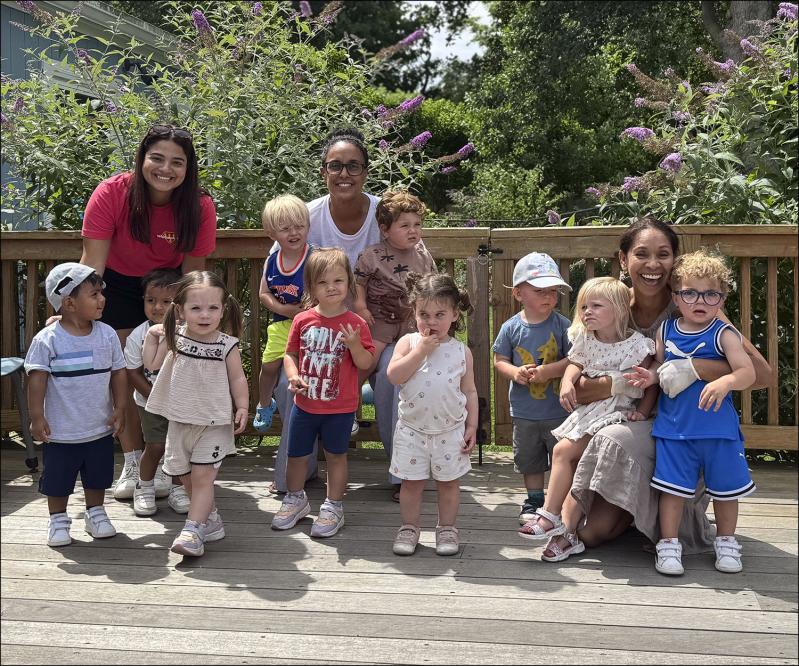In September, the Eleanor Whitmore Early Childhood Center will officially accept its first group of infants between 12 and 18 months — a longtime aspiration of the center’s board, and its namesake.
During an interview with The Star in 2005, an 80-year-old Eleanor Whitmore said that it was “her dream” for the center to be able to take on infants. “It takes two incomes for most families to make it today,” she said, “and their children are entitled to go into a safe place.”
Established in 1969 as the East Hampton Day Care Center, and renamed in 2013 in honor of Mrs. Whitmore, the nonprofit child care center provides full-day, affordable care and education for children ages 18 months to 4 years old.
The day care center at the Montauk Playhouse, run by Project Most, is the only other one locally to take younger children. Those in its care range in age from just 6 weeks up to 4 years.
“When I first got involved with the center, we had one toddler class and that was it. And that covers the ages of 18 to 35 months,” said Tim Frazier, the center’s executive director. It was a time of transition for the center — it had been running the prekindergarten program for the East Hampton School District for 20 years when the school board elected to move the program in-house to the John M. Marshall Elementary School building, in 2018.
“We had four classrooms of pre-K at the time, which really helped this place continue as a nonprofit, but then they were all pulled out. So we had to kind of rethink who we were, and what the need of the community was. And it was really clear, on our waiting list, that families were looking for something for younger children, so we started moving in that direction.”
The center now has five toddler classes, and will be repurposing its largest classroom for the babies at the end of the summer. There will be eight slots in the initial group, and as of last Thursday there were 51 names on the waiting list. “The older kids get, the more children you can have in the classroom,” explained Joan Overlock, the center’s director of development. As a licensed child care center, the facility has to operate in accordance with the strict regulations set out by the state’s Office of Children and Family Services. “With our toddlers we can have 12, but in some rooms we can’t have that many. And it’s not just an adult-child ratio, it’s the actual size of the classroom.”
In addition to the regulatory considerations, infants will present entirely new logistical challenges. “The exciting news is that the babies are coming — but we’ve never had kids who can’t walk yet,” Ms. Overlock said. “They can’t sit up by themselves. They can’t sit on a little chair at the table and eat. And if they can’t walk, we can’t take them outside — you know those hand-holding processions of kids? Not going to happen.”
“So, we have to have these special baby buggies that can have four kids in each one.” The center will also be adding cribs, new changing tables, high chairs, and rocking chairs, and smaller class sizes will naturally lead to a reduction in income from tuition, which will impact the budget.
“Our fees, out-of-pocket, sound like a lot of money — $375 a week,” said Ms. Overlock. “But that’s $7 an hour. Where are you going to find childcare for $7 an hour that has high quality, early education?”
The infant program will cost “a bit more” than the toddler program, but keeping costs down for families remains a priority. The center has appealed to the town to help offset some of the costs as part of its 2026 grant application, and Ms. Overlock has also been working on an initiative appealing directly to local businesses, asking them to consider subsidizing child care for their employees.
“If a big landscaping company here has a lot of our families as employees, and we give them, say, 30 or 50 percent of their tuition as a benefit, it would not only benefit the families, but it would benefit the companies by keeping their employees in a stable, consistent position,” Mr. Frazier said. “This is about creating habits and traits that our kids can take with them to school, wherever they go.”
“We feel like we need to be a part of the community — not just this little child care center tucked away down here,” he said. “That’s why we really focus on saying to the community, ‘We want to help support you and your growth — help us, too.’ Because if we work together, we can do amazing things for these families and their kids.”

